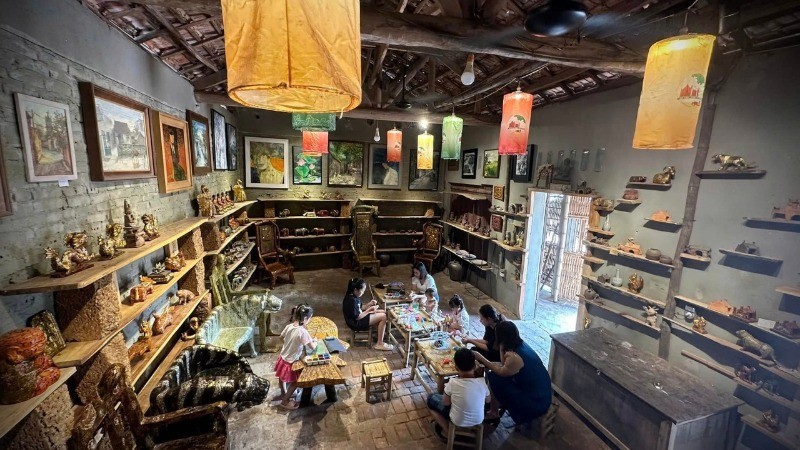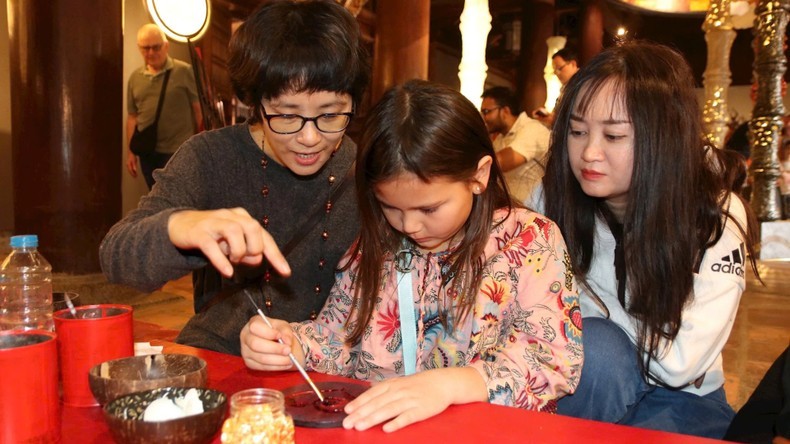Instead of just participating in “fun” experiential activities, tourists are now seeking deeper experiences, learning new skills and knowledge alongside local residents, and co-creating products with local artists and artisans. Creative tourism is emerging as both a new attraction and a driving force for the tourism industry, while affirming the cultural identities of each locality. It is both a growing trend and a practical solution that localities should adopt and expand.

Phat Studio’s creative space draws visitors with its artistic creations imbued with the countryside.
In the past, visitors to the ancient village of Duong Lam (Son Tay Township, Ha Noi) would typically tour the communal house, temples, and a few traditional houses, have lunch and then come home. Now, there are many factors that “keep” tourists.
Tourists become co-creators
One such destination is Phat Studio. Located in a small alley of the ancient village, Phat Studio remains a hot spot. It is not only the creative workshop of artisan Nguyen Tan Phat, but also a space for tourists to learn, experience, and create.
Following the success of his lacquer art, Nguyen Tan Phat introduced a new form of creative experience: crafting animals and objects from straw. Vietnam is a country of wet rice agriculture, so the use of straw to make rustic products is "fascinating" for tourists, especially international tourists.
Soon, Nguyen Tan Phat plans to launch a new line of creative experiences using laterite - characteristic of the Doai cultural region.
Alongside Phat Studio, visitors also find it easy to lose track of time at Doai Creative. This centre has made its mark by enabling tourists to paint or sculpt on old ceramic tiles. Today, visitors can also sculpt or paint on wood, make wood carvings, and make lanterns.
Khuat Quang Thang, founder of Doai Creative, shared: “Doai Creative always encourages visitors to engage in creative activities that reflect their personal expression. However, all of these experiences are rooted in the cultural values of rural life and the Doai region.”
As with Phat Studio, visitors to Doai Creative can take home the products they create. Duong Lam no longer just keeps tourists for a day - it now retains them overnight. In the mornings, it is not uncommon to see international visitors heading to the fields with hoes in hand and trying their hand at farming.
In recent years, experiential tourism has been increasingly developed when the cultural values and lives of local residents are exploited, creating interaction between tourists. Creative tourism has similarities with experiential tourism in that it is interactive, but it takes the experience to a new level.
According to Dao Minh Ngoc from Faculty of Tourism and Hospitality, National Economics University, creative tourism emphasises connections between tourists, nature, culture, and local communities. Travellers gain deeper insights into local traditions, lifestyles, customs, and arts, and are encouraged to participate in creative exchange and cultural sharing. While creative tourism was discussed in Viet Nam as early as a decade ago, it was only after the recovery phase following the COVID-19 pandemic - with rising demand for in-depth, distinctive experiences - that it truly began to flourish, particularly in traditional crafts, ancient villages, cuisine, and performing arts.
Major tourist destinations, traditionally known as the core of tourism activities, are also undergoing a creative transformation. At the Temple of Literature - Quoc Tu Giam, many visitors are surprised to discover a dedicated space for interactive and creative experiences designed specifically for tourists.
A variety of activities are offered in rotation, including watercolour painting, screen printing, rubber stamp carving, and lacquer painting. Under the guidance of artists and artisans, visitors can explore different art forms and try their hand at them.
Visitor Lan Huong shared: “My family and I spent the entire afternoon experimenting with lacquer painting. In the past, I would never have considered displaying a lacquer piece, but since this one is my own creation, I love it.”
According to Mr. Le Xuan Kieu, Director of the Centre of Science and Culture Activities of the Temple of Literature - Quoc Tu Giam, noted: “In our efforts to develop the Temple of Literature–Quoc Tu Giam into a creative space, we have partnered with several organisations, such as the Ha Noi Watercolour Club, Nhau Studio, and the University of Architecture. These creative activities are often linked to promoting the heritage values of the site. Tourists, especially young people and international visitors, are thrilled to make their own art and take it home. It’s a sustainable promotional method that encourages longer visits and adds value to the heritage site.”
As one of the country’s major tourism hubs, Ha Noi is also home to a vibrant network of creative tourism spaces. Notable examples include Magic of Colour (75 Hang Bo Street, Hoan Kiem District), which draws inspiration from traditional folk paintings; Indigo Store (Van Mieu Street, Dong Da District), specialising in handmade dyeing techniques; and Vun Art (Van Phuc, Ha Dong District), which uses scrap silk to create unique textile pieces.
In traditional craft villages such as Bat Trang ceramics (Gia Lam District), Thach Xa bamboo dragonflies (Thach That District), Ha Thai lacquerware (Chuong My District), and Phuong Duc toy figurines (Phu Xuyen District), tourism has evolved beyond simple “fun experiences” to offer more in-depth creative engagement.
Zo Project, a well-known creative space, offers workshops where guests can make products from dó paper, and even organises tours to see dó trees in bloom and learn about traditional papermaking. Even seemingly niche activities like dyeing, printing, and painting on linen have found an eager audience - many international tourists undertake long-term learning sessions at Indigo Store. These creative engagements naturally extend visitors’ stays and increase spending.

Artists and tourists creating lacquer works together at the Temple of Literature - Quoc Tu Giam
Integrating tourism into development of creative city
Several creative tourism models have emerged across Viet Nam. In Hoi An (Quang Nam Province), for instance, frequent flooding has been turned into a tourism product - “Hoi An in flood season” - which has received high praise from experts. However, Ha Noi remains the most active hub for creative tourism.
According to Le Anh Thu (UNESCO Office in Viet Nam), Ha Noi’s designation as a UNESCO Creative City of Design in 2019 marked a milestone and important step in unlocking the country’s creative tourism potential. Ha Noi can serve as a pilot model for other cities. It already possesses the key ingredients - hundreds of creative spaces, 1,350 craft villages, and a thriving community of top artists and artisans. As the market evolves, these artisans and creative spaces have swiftly adapted.
Despite its momentum, creative tourism still faces challenges. Some operators continue to confuse creative tourism with experiential tourism, missing out on opportunities to highlight new and unique activities. Creative tourism remains largely spontaneous, with few long-term strategies. However, this is gradually changing.
Since 2024, the city has launched dozens of Creative Design Centres in well-known craft villages such as Bat Trang ceramics, Trach Xa Ao dai, and Phu Vinh bamboo weaving. These centres serve as venues for showcasing, promoting, and selling OCOP (One Commune One Product) items linked to tourism.
Such models are gradually transforming how craft villages think about and attract visitors. Ha Noi is also developing two new resolutions of the municipal People’s Council: one on the organisation and operation of cultural industry centres, and another on cultural and commercial development zones. Organisations and individuals involved in these will enjoy many preferential policies and the “ecosystem” serving the creative cultural industry created by the city.
The city has also officially called on creative spaces to join the city Creative Spaces Network, set to launch in June 2025. The implementation of cultural industry policies and the development of the Creative City model will create mutual momentum with creative tourism.
To ensure the sustainable growth of creative tourism and help build a stronger national tourism brand, Pham Truong Hoang, Head of the Faculty of Tourism and Hospitality (National Economics University, Ha Noi), stressed the importance of developing human resources. Universities should adopt clear strategies to enhance training quality and foster environments that encourage innovation - places where students can develop new ideas and apply them in real life, he added.
Giang Nam - Translated by NDO